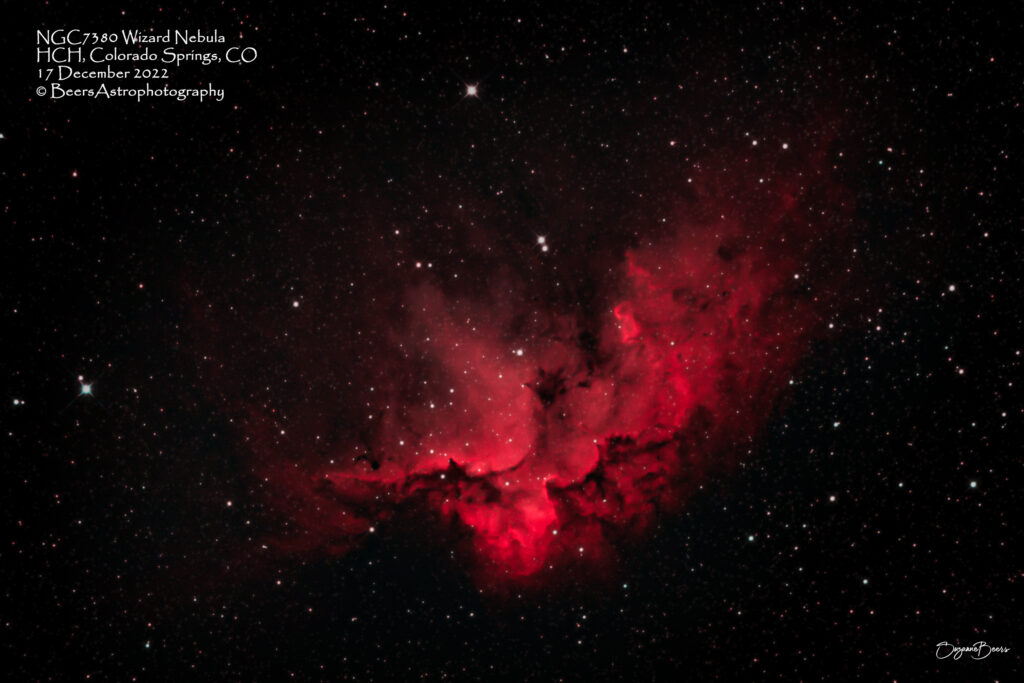
NGC7380 Wizard Nebula; Captured with Big Bertha from BLM land near Powderhorn, Colorado on 5 July 2024
Target Fun Facts
NGC 7380 is a young open cluster of stars in the northern circumpolar constellation of Cepheus, discovered by Caroline Herschel in 1787. The surrounding emission nebulosity is known as the Wizard Nebula, which spans an angle of 25′. The NGC 7380 complex is located at a distance of approximately 8.5 kilolight-years from the Sun, in the Perseus Arm of the Milky Way.
The cluster spans ~20 light-years with an elongated shape and an extended tail. Age estimates range from 4 to 11.9 million years. At the center of the cluster lies DH Cephei, a close, double-lined spectroscopic binary system consisting of two massive O-type stars. This pair are the primary ionizing source for the surrounding H II region, and are driving out the surrounding gas and dust while triggering star formation in the neighboring region.
Other Designations: NGC 7380, Sh2-142, Cr 45
Subtype: Open Star Cluster/Emission Nebula
Distance from Earth: 8500 ± 1300 light years
Size (radius): ~20 light years
Size (apparent dimensions): 25’x20′
Visual Magnitude: 7.2
Constellation: Cepheus
{ Information from: Stellarium and https://en.wikipedia.org/wiki/NGC_7380 }
Equipment
Equipment: All equipment controlled by HP Probook running Sequence Generator Pro v4.4.0.1339.
- Imaging (ASI2400-BB): ZWO ASI2400MC imaging camera on (Big Bertha) Orion 8″ f/8 Ritchey-Chretien Astrograph Telescope
- Autofocuser: ZWO EAF Electronic Automatic Focuser – Standard (EAF-5V-STD)
- Mount: Rainbow Astro RST-135E (controlled by iHubo ASCOM driver)
- Polar alignment: QHYCCD camera (controlled by Polemaster for polar alignment)
- Autoguiding: Orion 60mm Multi-Use Guide Scope with Orion StarShoot AutoGuider Pro Mono Astrophotography Camera (controlled by PHD2)
Capture & processing notes
This image was captured as the second image of the night, on our July 2024 dark skies trip’s second night. During the day, I had attached the ZWO EAF to Big Bertha and set the focuser settings in SGP to the same (changed) settings I had established for the Southern Cross (7 data points, 75 steps). I selected targets for the night: SH2-126 Gecko Nebula for the Southern Cross; M8 Lagoon Nebula and NGC7380 Wizard Nebula for Big Bertha.
During the imaging of M8 Lagoon Nebula, the EAF kept failing so I turned it off and didn’t use it for the rest of the trip – vowing to do some research and practicing when I was not burning precious dark skies times. I had been debating whether I was going to make the switch to NGC7380 spend the entire night imaging M8. The individual subframes of M8 looked great as they were being gathered, so I decided to continue with my plan of changing targets at M8’s meridian flip (~0035) to the Wizard Nebula for the rest of the night.
Sequence plans: Gain: 158, Temp: -0°C, offset=30. 43x5min. Captured 6Jul2024, 0054MDT – 0438MDT. Total exposure time: 3:35hrs (215min, ASI2400-BB)
Capture Date: 5 July 2024
Shooting location: BLM land near Powderhorn, Colorado
Processing: Captured with SGP, stacked in APP, star removal with Starnet++, processed in LR/PS.
Additional image of NGC7380 Wizard Nebula

Equipment
Polar alignment: QHYCCD camera (controlled by Polemaster)
Imaging stream: Orion 10″ f/8 Ritchey-Chretien Astrograph Telescope; Canon EOS Ra with with Teleskop Service Flattener 1.0x for RC Telescopes (TS-RCFLAT2) and Optilong L-eXtreme light pollution filter
Mount: Sky-Watcher EQ6-R Pro Equatorial Mount (controlled by EQMOD)
Autoguider: Orion 60mm Multi-Use Guide Scope, Orion StarShoot AutoGuider Pro Mono Astrophotography Camera (controlled by PHD2)
All equipment controlled by HP Probook running Sequence Generator Pro v3.2.0.660.
Capture & processing notes
Sequence plans: ISO3200; 70x300sec; captured 17Dec2022 1753MST – 18Dec2022, 0000MST. Total exposure time: 5:50hrs.
Capture: 17 December 2022
Shooting location: Colorado Springs, Colorado
Processing: Stacked in APP, processed in LR/PS.
